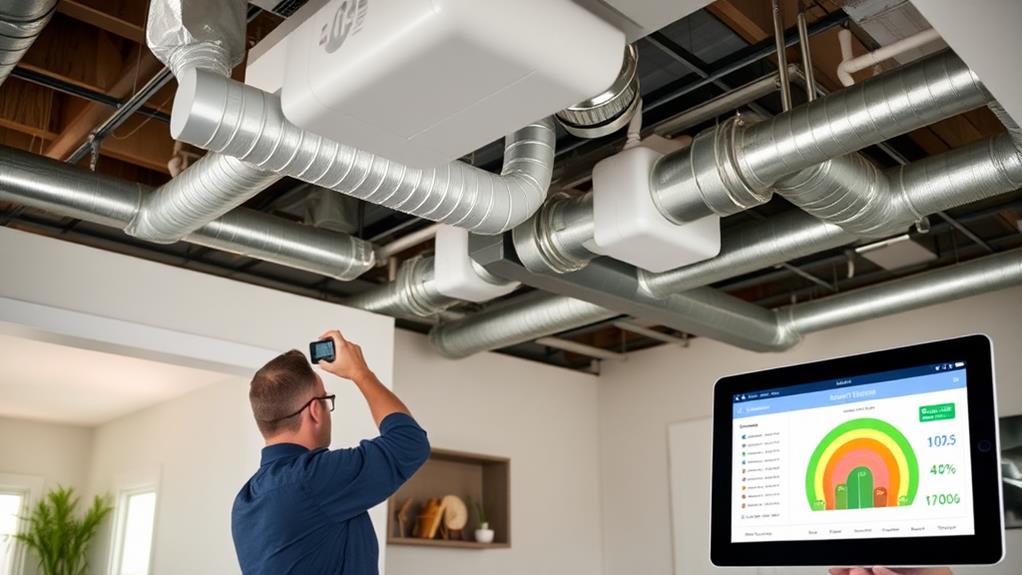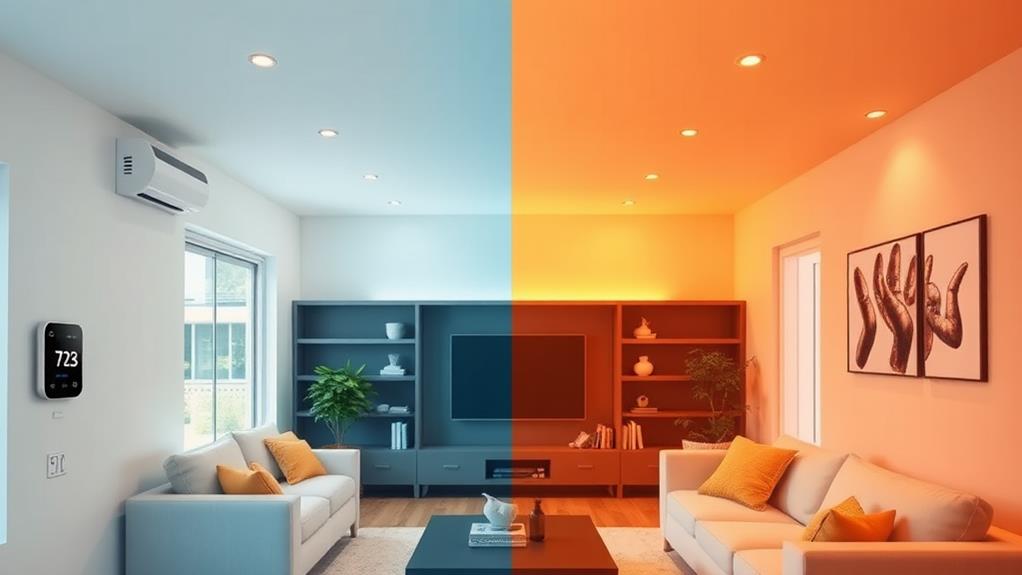Zoned HVAC systems divide your home into multiple areas, each with its own thermostat and temperature control. By using dampers in the ductwork, these systems direct airflow to specific zones, allowing you to customize comfort and save energy. You'll enjoy improved comfort, reduced energy waste, and extended HVAC system lifespan. Installation involves setting up dampers, thermostats, and a central control panel. While initial costs range from $2,000 to $7,000, long-term energy savings can offset this investment. Regular maintenance, including filter changes and professional servicing, keeps your system running efficiently. As technology advances, zoned HVAC systems are becoming smarter and more integrated with IoT devices, promising even greater control and efficiency.
Understanding Zoned HVAC Systems

When you think about your home's heating and cooling, you might picture a single thermostat controlling the entire house. However, zoned HVAC systems offer a more sophisticated approach to temperature management. These systems divide your home into multiple zones, each with its own thermostat and control.
Zoned HVAC systems use dampers in the ductwork to direct airflow to specific areas. This allows you to set different temperatures for various parts of your home, addressing unique comfort needs and energy usage patterns. For instance, you can keep bedrooms cooler at night while reducing energy use in unoccupied areas.
The primary components of a zoned system include a central control panel, zone thermostats, and motorized dampers. The control panel acts as the brain, coordinating input from thermostats and adjusting dampers accordingly. You'll typically find zoned systems in larger homes, multi-story buildings, or houses with distinct temperature requirements in different areas.
Benefits of Zoning
Over time, homeowners have discovered numerous advantages to zoned HVAC systems. You'll experience improved comfort as you can customize temperatures in different areas of your home. No more arguments about thermostat settings – everyone can have their preferred temperature in their own space.
Energy efficiency is a significant benefit. You'll save money on utility bills by only heating or cooling occupied areas. This targeted approach reduces energy waste and minimizes your carbon footprint. Zoning also extends the life of your HVAC system by reducing its overall workload.
You'll appreciate the flexibility zoning offers. It allows you to adapt to changing needs throughout the day or season. For example, you can keep bedrooms cooler at night while maintaining a warmer temperature in living areas during the day.
Zoned systems can address architectural challenges in your home. They're particularly useful for multi-story houses, homes with large windows, or spaces with high ceilings. By creating separate zones, you can effectively manage temperature variations caused by these features.
Lastly, zoning can increase your home's value. Potential buyers often view energy-efficient features as desirable, making your property more attractive in the real estate market.
Installation and Setup Process

Now that you understand the benefits of zoned HVAC systems, let's explore the installation and setup process. To begin, you'll need to assess your home's layout and identify distinct zones based on usage patterns and temperature preferences. A professional HVAC technician will help you determine the optimal number and placement of zones.
Next, you'll install dampers in your existing ductwork to control airflow to each zone. These dampers are connected to a central control panel, which communicates with individual thermostats in each zone. The technician will also install a bypass damper to manage air pressure when some zones are closed.
You'll then set up programmable thermostats in each zone, allowing for customized temperature schedules. The control panel is configured to manage these thermostats and coordinate the system's operation. Your HVAC professional will calibrate the system, ensuring proper airflow and temperature control in all zones.
Cost Considerations
The cost of installing a zoned HVAC system can vary significantly based on several factors. You'll need to consider the size of your home, the number of zones you want to create, and the complexity of the installation process.
On average, you can expect to pay between $2,000 and $7,000 for a zoned system, with larger homes and more zones pushing costs toward the higher end.
While the initial investment may seem steep, it's essential to weigh it against the long-term savings. You'll likely see a reduction in your energy bills, as you'll no longer be heating or cooling unused areas of your home. Additionally, zoned systems can extend the life of your HVAC equipment by reducing its overall workload.
When budgeting, don't forget to factor in ongoing maintenance costs. While these aren't typically higher than those for traditional systems, regular upkeep is crucial for optimal performance. You might also want to consider smart thermostats for each zone, which can add to the initial cost but provide greater control and potential energy savings in the long run.
Maintenance and Troubleshooting

Regular maintenance is essential for keeping your zoned HVAC system in top shape. You should change air filters every 1-3 months, depending on usage and air quality. Clean supply and return vents regularly to ensure proper airflow.
Inspect and clean condensate drains annually to prevent clogs and water damage. Have a professional technician service your system twice a year to check refrigerant levels, clean coils, and calibrate thermostats.
If you encounter issues, start by checking your thermostat settings and batteries. Ensure all dampers are functioning correctly and not stuck. Listen for unusual noises that might indicate mechanical problems.
If one zone isn't cooling or heating properly, check for blocked vents or dirty filters. Uneven temperatures between zones could signal a faulty damper or thermostat.
For more complex issues, don't hesitate to call a professional. They can diagnose problems with zone control panels, damper motors, or refrigerant leaks. Keep a log of any issues you notice, including specific zones affected and when problems occur. This information will help your technician troubleshoot more effectively, saving you time and money on repairs.
Future of HVAC Zoning
Looking ahead, HVAC zoning technology is poised for significant advancements. You'll see smarter systems that integrate with the Internet of Things (IoT), allowing for more precise control and automation. These systems will learn your preferences and habits, adjusting temperatures automatically based on your daily routines and weather forecasts.
Artificial intelligence will play a crucial role in optimizing energy efficiency. AI-powered zoned HVAC systems will predict your comfort needs and adjust accordingly, minimizing energy waste. You'll also witness the rise of voice-controlled zoning, enabling you to adjust temperatures in different rooms using simple voice commands.
Improved sensor technology will lead to more accurate temperature and occupancy detection. This will result in even more efficient zoning, as your system will know exactly which rooms are in use and require conditioning. Additionally, you'll see advancements in ductless mini-split systems, making zoning easier and more affordable for older homes.
Expect to see better integration with renewable energy sources, such as solar panels, allowing your zoned HVAC system to operate more sustainably. These innovations won't only enhance your comfort but also significantly reduce your energy bills and environmental impact.
Conclusion
You've seen how zoned HVAC systems offer personalized comfort and energy savings. While installation costs may seem daunting, the long-term benefits are undeniable. As you embrace this technology, you'll experience both warmth and cool savings. Don't let your home remain a climate battleground; instead, create harmony through zoning. With proper maintenance, your system will serve you well. As HVAC zoning evolves, you're not just controlling temperature—you're shaping the future of home comfort.

